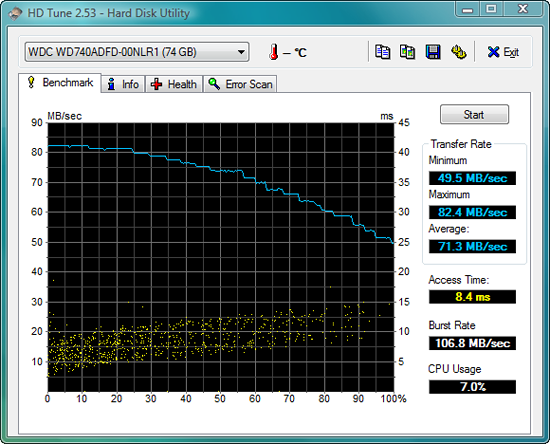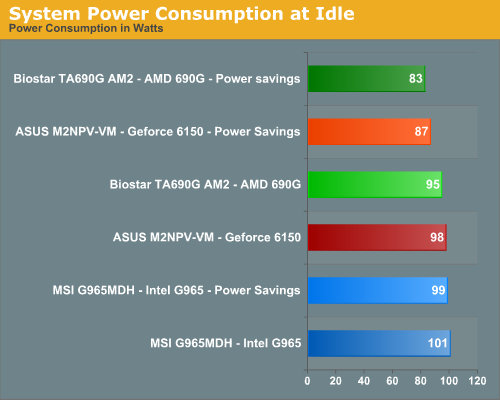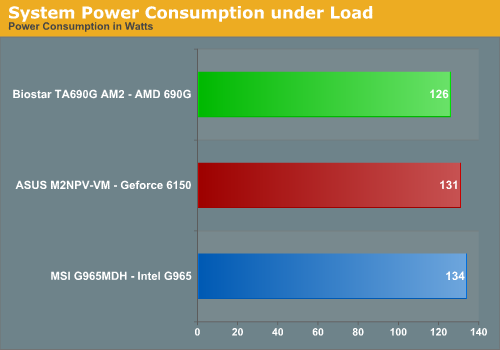Disk Controller Performance
The normal AnandTech iPeak test for measuring storage controller performance is designed to keep the hard drive as consistent as possible while varying the hard drive controller. The idea is to measure the performance of each hard drive controller with the same hard drive. Unfortunately, we discovered that iPeak does not work properly under Microsoft Vista at this time. We are currently looking at alternative test methods but will present HD Tune 2.53 results today.



The performance pattern according to these results would lead one to believe that the NVIDIA 6150/430 offers the worst disk performance as its minimum, maximum, and average transfer rates are the worst in the group, but it does have the best burst rates. The G965's ICH8 and 690G's SB600 Southbridge designs score identically in the first series of tests with the SB600 providing a higher burst rate at the expense of CPU utilization. In actual application testing, we generally found the NVIDIA 6150/430 offered the best overall disk performance.
Power Consumption
We measured power consumption at two states: at idle sitting at the Vista desktop and under load while running our 3DMark06 test. At both settings, Cool 'n Quiet/EIST were enabled to keep power consumption down to a minimum, although the biggest difference is made at idle.


In our idle tests we see that both AM2 platforms have an advantage over the Intel platform with or without power management turned on. In previous testing we know the Intel Core 2 Duo consumes less power than our 90nm 5200+ X2 samples, which indicates the G965 chipset is a power hog when compared to the AM2 solutions. The 690G scores extremely well in both our Idle and Load tests.
The normal AnandTech iPeak test for measuring storage controller performance is designed to keep the hard drive as consistent as possible while varying the hard drive controller. The idea is to measure the performance of each hard drive controller with the same hard drive. Unfortunately, we discovered that iPeak does not work properly under Microsoft Vista at this time. We are currently looking at alternative test methods but will present HD Tune 2.53 results today.



The performance pattern according to these results would lead one to believe that the NVIDIA 6150/430 offers the worst disk performance as its minimum, maximum, and average transfer rates are the worst in the group, but it does have the best burst rates. The G965's ICH8 and 690G's SB600 Southbridge designs score identically in the first series of tests with the SB600 providing a higher burst rate at the expense of CPU utilization. In actual application testing, we generally found the NVIDIA 6150/430 offered the best overall disk performance.
Power Consumption
We measured power consumption at two states: at idle sitting at the Vista desktop and under load while running our 3DMark06 test. At both settings, Cool 'n Quiet/EIST were enabled to keep power consumption down to a minimum, although the biggest difference is made at idle.


In our idle tests we see that both AM2 platforms have an advantage over the Intel platform with or without power management turned on. In previous testing we know the Intel Core 2 Duo consumes less power than our 90nm 5200+ X2 samples, which indicates the G965 chipset is a power hog when compared to the AM2 solutions. The 690G scores extremely well in both our Idle and Load tests.










70 Comments
View All Comments
SignalPST - Tuesday, March 6, 2007 - link
I'm interested in this topic as well.Then again, I still waiting for them to come out with a HDMI sound card.
StriderGT - Wednesday, March 7, 2007 - link
Unfortunately there are lots of us who are still waiting for a true HDMI PC audio solution. You can check the thread I started with many technical details for that matter here: http://www.avsforum.com/avs-vb/showthread.php?t=79...">http://www.avsforum.com/avs-vb/showthread.php?t=79...Patrese - Tuesday, March 6, 2007 - link
Great review, thanks... I know I asked that a couple times already, but is there a mATX roundup planned here at AT? I'd like to see the Asus M2NPV-VM and Abit NF-M2 NView compared with its 690G counterparts, as this segment makes for most of the computer sales on most places? BTW, weren't you plaged by memory compatibility issues with the M2NPV-VM oe any of the boards tested? This Asus board showed extremely picky on my experience...Gary Key - Wednesday, March 7, 2007 - link
The roundup is scheduled on the 19th, trying to pull it in. What BIOS and memory are you using on the M2NPV-VM, so far I have not run into any real issues except with 2GB modules. The abit board is one of my favorites so far. ;)Patrese - Tuesday, March 6, 2007 - link
There shouldn't be a question mark at the end of the "most sales" phrase... There are also a couple typos, sorry about that. Where's the edit button anyway? ;)RamarC - Tuesday, March 6, 2007 - link
i don't really understand the point of comparing chipsets/motherboards between processor families. subsystem performance figures can show glaring deficiencies but otherwise it really boils down to a cpu comparison. the "media/audio encoding" and "media performance" sections are certainly cpu-centric. and pitting a $230 x2 5200+ against a $185 e6300 winds up handicapping the intel contestant. shouldn't the $222 e6400 have been used instead?Gary Key - Tuesday, March 6, 2007 - link
As stated in the article, AMD is marketing the AM2 and 690G/V as a platform design to compete against the G/Q965 and Core 2 Duo solution. The 690G is targeted to the multimedia, HTPC, home/office, casual gaming crowd and was tested as such. We looked at the total price of a base Core 2 Duo and decent G965 board and then matched the processor choice that would come closest to the price and performance of the Intel offering while meeting the platform cost. Our tests were chosen based upon the target audience for each platform in the home environment. This was not a review of office level machines as the Q965/963 and 690V are targeted to the business user.JarredWalton - Tuesday, March 6, 2007 - link
The conclusion mentions that the G965 + E6300 costs around $300 compared to $315 for the 690G + 5200+ (or 6150 + 5200+), so it's more or less a fair "equivalent price" platform comparison. The E6400 ends up being faster than the E6300, but still slower in a few tests (as the text mentions) and even faster in those tests where E6300 already holds the lead. Nothing new there - we've pretty much beat the "Core 2 Duo is faster" drum to death. We feel anyone looking at 690G is going to be interested in the platform as a whole much more than whether or not it is faster than equivalently price Core 2 offerings.mostlyprudent - Tuesday, March 6, 2007 - link
There may be too many variables, but perhaps you could come up with a way to normalize the benchmarks. For instance, run the gaming tests first with ultra high-end graphics to try and isolate the performance delta for each plattofrm/cpu combo you will test with. Then run the game benchmarks with the IGP solutions and adjust the scores based on the previous tests. Just a thought off the top of my head.asliarun - Tuesday, March 6, 2007 - link
Ah, but you're evaluating a chipset here, not a platform or a system solution. Having said that, I agree that it IS difficult to compare chipsets that are targeted for different CPUs. In such a case, a better way to evaluate might be to take an AMD and an Intel CPU that is similar in performance (not in price), and use them to compare their corresponding chipsets. That would highlight the differences between the chipsets. You could always mention the price alongside, or do a separate price/performance comparison alongside.My point is that a price/performance comparison should complement a pure performance comparison, not the other way around.